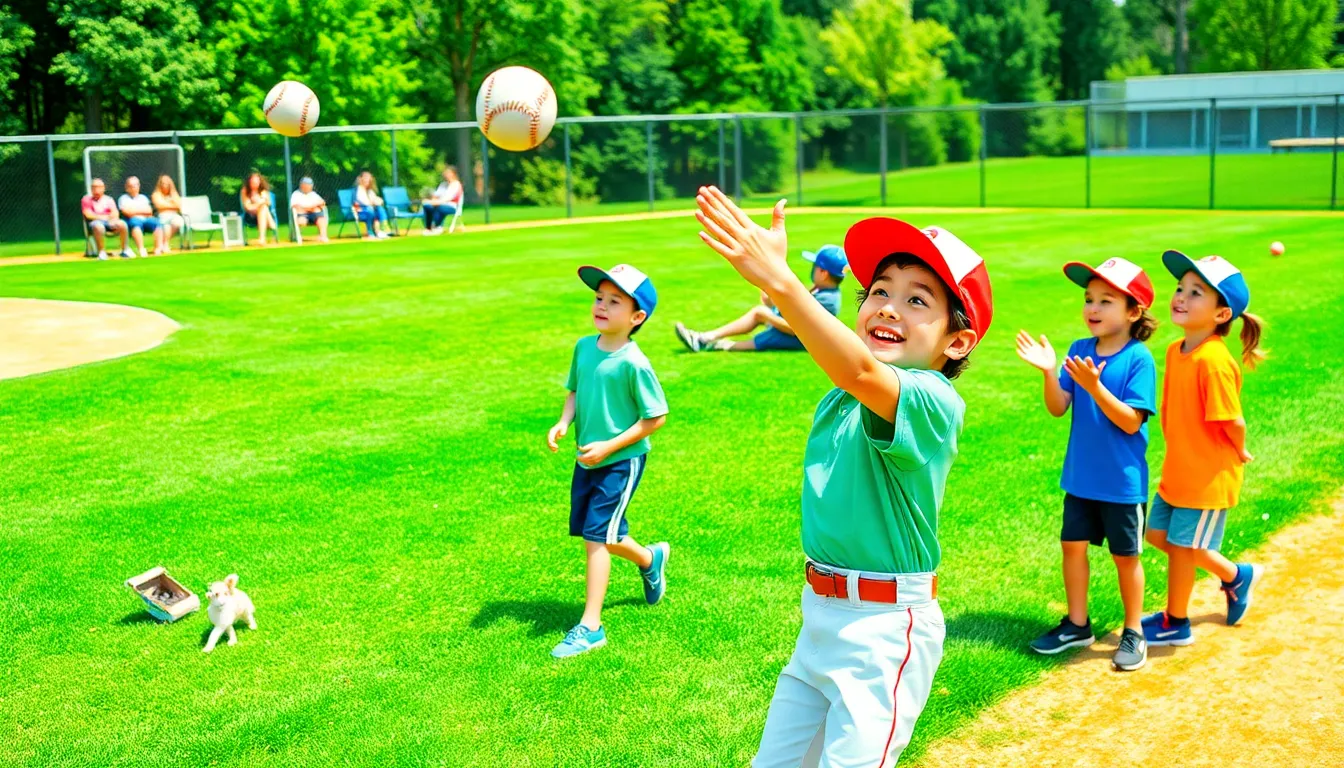Table of Contents
ToggleLittle League baseball isn’t just a game; it’s a rite of passage. Picture this: kids running around bases like their lives depend on it, parents cheering from the sidelines, and the occasional snack break that turns into a full-blown picnic. It’s where future stars are born, and where parents discover that their little ones can hit a home run—or at least a solid grounder.
With its mix of competition and camaraderie, Little League serves up life lessons alongside those baseballs. Kids learn teamwork, sportsmanship, and how to handle a good-natured ribbing from their teammates. Whether it’s the thrill of a walk-off win or the agony of a strikeout, every moment on the field shapes their character. So grab your glove, lace up those cleats, and get ready to dive into the delightful world of Little League baseball, where every game is a story waiting to be told.
Overview of Little League Baseball
Little League baseball provides children aged 4 to 16 the opportunity to engage in organized sports within a supportive framework. Teams compete in local leagues, fostering an environment for young athletes to develop skills and friendships. Parents and guardians often play a vital role, providing encouragement and guidance during practices and games.
Participants experience various divisions based on age and skill level. For example, T-Ball introduces the game to the youngest players, while the Major League division challenges older kids with competitive play. Coaches facilitate the growth of players by teaching fundamental techniques, strategies, and the importance of sportsmanship.
Life lessons emerge throughout the season. Players learn teamwork, as they rely on one another to achieve shared goals. They also embrace the spirit of competition, understanding that both wins and losses contribute to personal growth and resilience. Consistent practice helps athletes refine their abilities while building confidence.
Community involvement enhances the atmosphere surrounding Little League baseball. Local businesses often sponsor teams, promoting camaraderie and support. Events like opening days or tournaments engage families, creating a sense of belonging among players and spectators alike.
Ultimately, participation in Little League baseball shapes character and nurtures lifelong values. Children cultivate social skills, build friendships, and discover their passions through the sport. Every game and practice contributes to their growth, setting the foundation for future endeavors both on and off the field.
History of Little League Baseball

Little League baseball has roots that extend back to the early 20th century. Founded in 1939 by Carl Stotz in Williamsport, Pennsylvania, it began as a response to the need for organized youth sports. Stotz aimed to provide children with a platform for healthy competition and personal development.
Founding and Development
The league’s first three teams, named the “Fossum’s”, “Grotto’s”, and “Lycoming,” played in a modest setting. Initially, Little League started with boys aged 8 to 12, focusing on instilling valuable values like teamwork and sportsmanship. It has expanded since its inception to accommodate girls, following the establishment of the Softball program in 1974. This increase in participation paved the way for more inclusive practices, reflecting societal changes over the years. Community support played a crucial role in Little League’s growth, fueling its popularity across the United States and beyond.
Major Milestones
Significant moments punctuate Little League’s journey. In 1947, the first Little League International Tournament took place, showcasing the competitive spirit at a national level. With the introduction of the Little League World Series in 1947, the competition offered a prestigious platform for young athletes. Expansion happened rapidly, as leagues sprouted internationally in the 1950s and 1960s. By 1964, Little League had reached 1 million registered participants. Major milestones reflect Little League’s commitment to youth development and community engagement, highlighting its enduring impact in youth sports.
Rules and Regulations
Little League baseball follows specific rules and regulations that promote fairness and safety. These rules guide gameplay and ensure an enjoyable experience for all participants.
Age Divisions
Little League baseball organizes athletes into various age divisions. T-Ball accommodates children aged 4 to 6, introducing the basics of the game. Minor League serves players aged 7 to 9, focusing on skill development and teamwork. Major League includes ages 10 to 12, where competition heightens with an emphasis on advanced strategies. Intermediate and Junior Leagues cater to 13 to 15-year-olds, allowing for more complex gameplay. Lastly, the Senior League supports players aged 16, providing opportunities for older youth to compete at a higher level.
Gameplay Guidelines
Gameplay guidelines ensure a consistent experience across divisions. Each team fields nine players in a standard game. Batters receive a specified number of pitches or strikes before striking out. Base running rules enforce limited lead-offs and stealing bases based on age divisions. Game duration varies, with games lasting six innings or a specified time limit. Coaches emphasize sportsmanship, reinforcing positive behavior during play. Safety protocols, including mandatory use of helmets and shin guards, reduce injury risks for young athletes.
Benefits of Little League Baseball
Participation in Little League baseball offers numerous benefits for young athletes, significantly impacting their development.
Physical Health
Young athletes improve their physical health through regular practice and games. Active participation enhances cardiovascular fitness, builds strength, and develops coordination. It promotes good habits, contributing to a healthier lifestyle. Engaging in baseball cultivates teamwork and camaraderie, encouraging players to support one another during practices and games. As they practice skills like throwing, hitting, and running, they also strengthen their motor skills and overall fitness levels. Consistent exercise leads to better physical performance, helping children become active and energetic learners both on and off the field.
Social Skills
Players in Little League baseball cultivate essential social skills within a team environment. Working together fosters communication and cooperation, which benefits children both on and off the field. Establishing friendships among teammates enhances their social circle, creating a sense of belonging. Through shared experiences in practices and games, they learn to navigate conflicts and develop empathy. Coaches and mentors play a crucial role in teaching valuable lessons about respect and sportsmanship, reinforcing the importance of fair play. Engaging in team activities builds confidence, setting the foundation for effective interpersonal relationships throughout their lives.
Challenges Facing Little League Baseball
Little League baseball faces several challenges impacting its growth and sustainability. Changes in participation rates and safety concerns pose significant hurdles for leagues.
Participation Rates
Declining participation in youth sports raises alarms. According to studies, enrollment in Little League baseball has dropped by approximately 20% in the last decade. This trend often stems from increased competition from other activities, like soccer and basketball. Families prioritize academic commitments and screen time, leading to fewer children signing up for baseball. Additionally, cost barriers in some regions prevent access to organized play. Local leagues strive to increase outreach and engagement, aiming to attract more players. Offering incentives, such as scholarships or free clinics, can revive interest in this cherished pastime.
Safety Concerns
Safety remains a top priority in youth sports, including Little League baseball. Reports of injuries lead to heightened awareness among parents and officials. Concussions and overuse injuries have emerged as critical concerns, prompting leagues to adopt stricter safety protocols. Equipment standards must be regularly updated to ensure player protection. Regular training for coaches on injury prevention and response to medical emergencies contributes to safer environments. Increased attention to mental health also plays a role in player well-being, as stress and anxiety can impact performance and enjoyment. Addressing these safety matters helps maintain trust among families and protects young athletes.
Little League baseball represents a vital part of childhood development. It fosters not only athletic skills but also essential life lessons that resonate long after the final game. The camaraderie among teammates and the support from families create a nurturing environment that helps children thrive.
As communities work to address participation challenges and safety concerns, the spirit of Little League remains strong. Its rich history and commitment to youth development continue to inspire future generations. The values instilled through this beloved sport lay the groundwork for lifelong friendships and personal growth, ensuring that Little League baseball will remain a cherished tradition for years to come.





